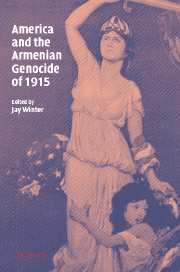Book contents
- Frontmatter
- Contents
- List of contributors
- Map
- Acknowledgments
- Introduction: witness to genocide
- Part 1 The framework
- 1 Twentieth-century genocides
- 2 Under cover of war: the Armenian Genocide in the context of total war
- 3 The Armenian Genocide: an interpretation
- Part II During the Catastrophe
- Part III After the Catastrophe
- Index
- Studies in the Social and Cultural History of Modern Warfare
3 - The Armenian Genocide: an interpretation
Published online by Cambridge University Press: 04 September 2009
- Frontmatter
- Contents
- List of contributors
- Map
- Acknowledgments
- Introduction: witness to genocide
- Part 1 The framework
- 1 Twentieth-century genocides
- 2 Under cover of war: the Armenian Genocide in the context of total war
- 3 The Armenian Genocide: an interpretation
- Part II During the Catastrophe
- Part III After the Catastrophe
- Index
- Studies in the Social and Cultural History of Modern Warfare
Summary
Introduction
The Armenian Genocide, perpetrated during the First World War, is significant for several reasons. First and foremost, that Genocide was the devastating culmination of a series of antecedent massacres. These massacres were consummated in the decades preceding 1914, especially those of 1894–6, the era of Sultan Abdul-Hamid, and that of Adana in 1909. The latter massacre more or less coincided with the advent of the (Ittihadist) Young Turk regime. Operating under the designation “Committee of Union and Progress” (CUP), the leaders of that regime came to power by overthrowing Sultan Abdul-Hamid in 1908 in a more or less bloodless revolution. Adopting the clarion calls of the French Revolution, i.e., freedom, equality, and brotherhood, these leaders had proposed to supplant the preceding despotic regime by a constitutional one. Yet, by a twist in the turn of events, they ended up becoming the lethal nexus between the massacres of that preceding regime and those of the subsequent ones, thus ushering in the era of the most comprehensive of all massacres, namely, the World War I Genocide.
Within this perspective, this genocide emerges as a developmental event, punctuated by a history of accumulative tensions, animosities, and attendant sanguinary persecutions. It marks a phenomenon that is anchored on a constantly evolving and critically escalating perpetrator-victim conflict. Such a framework of analysis precludes the consideration of the argument that the Armenian Genocide was more or less a by-product of the exigencies and consuming crises of the first global war.
- Type
- Chapter
- Information
- America and the Armenian Genocide of 1915 , pp. 52 - 100Publisher: Cambridge University PressPrint publication year: 2004
- 2
- Cited by

